FSO无线光通信英文介绍
- 格式:ppt
- 大小:4.49 MB
- 文档页数:18
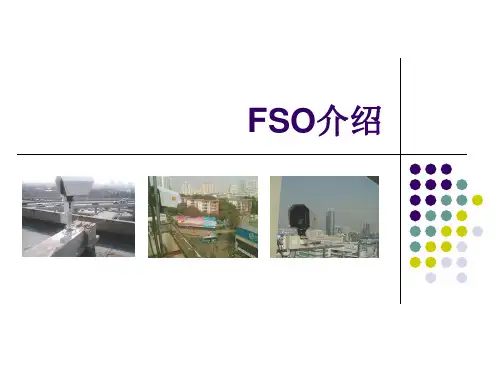

自由空间光通信技术的应用和发展
XXXXXXXXXXXXX XXXXXXXXXXXX 自由空间光通信技术的应用和发展 摘要: 无线光通信又称自由空间光通信(FSO),是一种以激光为载波(MHz), 在真
空或大气中传递信息的通信技术。F S O在视距传输、宽带接入中逐渐得到了的应用。本文简单介绍了自由空间无线光通信技术的技术背景和国内外发展现状、其基本原理、系统组成和相关的关键技术,并指出,随着“最后一公里”对高带宽、低成本接入技术的迫切需求,F S O技术具有越来越广泛的前景。 关键词:自由空间光通信(FSO);最后一公里技术
1. FSO技术背景[1] 自由空间光通信FSO( Free space optics),是一种小功率红外激光束通过大气为介质传送光信号的激光通信系统它有两种工作波长:分别是850nm和1550nm。850nm的设备相对便宜,一般主要应用在传输距离不太远的场合;1550nm的设备价格要昂贵一些,但在功率、传输距离和视觉安全方面有更好的表现。FSO和光纤通信一样,具有频带宽的优势,能支持155Mb/s~10Gb/s的传输速率,传输距离可达2~4km,但通常在1~2km有稳定的传输效果。在20 世纪80 年代FSO开始用于军方,随着掺饵光纤放大器EDFA、波分复用WDMA、自适应光学Adaptive Optics 等技术不断发展,无线光通信在传输距离、可靠性、传输容量等方面有了较大改善, 适用面也越来越宽。 虽然无线光通信技术还有待成熟,但它却有显著的优点: (1) 频带宽,速率高:理论上,无线光通信的传输带宽与光纤通信的传输带宽相同。目前国外无线光通信系统一般使用1550n m波长,传输速率可达10Gbit/s,可完成12万个话路,其传输距离可达5k m。 (2) 频谱资源丰富:FSO设备多采用红外光传输方式,无需申请频率执照和交纳频率占用费,也不会和微波等无线通信系统产生相互干扰。 (3) 适用多种通信协议:无线光通信产品作为一种物理层的传输设备,可以用在SDH、ATM、以太网、快速以太网等常见的通信网络中。 (4)部署链路快捷:FSO设备可以直接架设在楼顶,甚至可在水域上部署,能完成地对空、空对空等多种光纤通信无法完成的通信任务,其施工周期较短,可以在数小时内建立起通信链路,而建设成本只有地下光纤的五分之一左右。 (5)传输保密性好:无线光通信的安全性高。无线光通信具有很好的方向性和非常窄的波束,因此,对其窃听和人为干扰较困难。 (6)组网灵活:可以构建点地点,点对多点,环状,星状,网状等多种结构。并且网络的扩展容易。 2.FSO在国内外发展历程[2~3] 早在20世纪60年代,人们就对自由空间光通信进行过研究,但当时主要用于军事及实验目的,其商业应用是在最近几年才在美国兴起。90年代 FSO 系统的厂商围绕着技术的经济性来开发他们的产品, 因为安装屋顶到屋顶的FSO 链路比挖掘城市街道、安装光纤线路快捷便宜得多。同时无线通信所赖以生存的射频频谱正在变得十分拥挤, 很难再支撑高速宽带大容量无线通信应用。于是, 人们又将目光转向了无线光通信。 国际上,一些大型电信设备公司对FSO系统产生了极大的兴趣,如美国、俄罗斯、加拿大及西欧的一些发达国家已开始试用这种系统。比较典型产品有As-troTerra公司的TERRALINK4-155系列产品、Air-Op-tica公司的UWIN802,PLH802系列和PAV数据系统公司的SKY系列产品。1999年,光通信的巨头朗讯公司做了相距2.4km、速率为2.5Gb/s、波长为1550nm的无线光通信实验;2000年做了40Gb/s密集波分复用4.4km无线光通信实验。据2001年有关文献报道,朗讯公司做了目前通信容量最大的FSO通信系统试验采用光纤放大器可以在200m的通信距离内,实20Gb/s-160Gb/s速率的数据通信,这项技术代表着国际最高水平。Light-Pointe公司自从2004年推出的FlightLite一直是最畅销的企业无线产品之一,而Light-Pointe又于05年五月份推出FlightStrata100XA, 是第一款集成了快速以太网光无线链路和5.8GHzRF技术的FSO 产品。该产品提供了全天候的工作能力,同时可以提供与光纤线路一样的带宽。 在国内,从事FSO研究的主要有中国电子科技集团公司第34研究所(桂林)、成都光电技术研究所及上海光机所等单位。中国电子科技集团公司第34研究所早1971年就开始进行FSO技术研究。1997年,该所派专家赴俄罗斯进行实地考察FSO的应用情况,之后组建了技术攻关小组。经过近几年的努力,34所已成功开发出了一系列的FSO设备,如:专用网接入系列、以太网专用系列、图像传输专用系列、GSM信号传输系列等。 目前,34所已完成155Mb/s、622Mb/s速率的超长距离带有自动跟瞄系统的大气通信系统。成都光电技术研究所已经开发出了工作波长为850nm,可以传输1km、4km两种距离的两款产品。后来,清华同方公司推出的FSO产品TFOW100-1能提供100Mbps的带宽,用于1km以内的网络接连,该产品的特点是采用小功率激光器,所以大幅降低成本。根据华为公司与Light-Pointe 公司04年7月的OEM合作协议,华为将在欧洲,中东等地将LightPoint的产品作为自己光网络产品的部分销售。华为已成功将FSO产品安装到国内的各大运营网络中,这表示华为是世界一流的供应商。
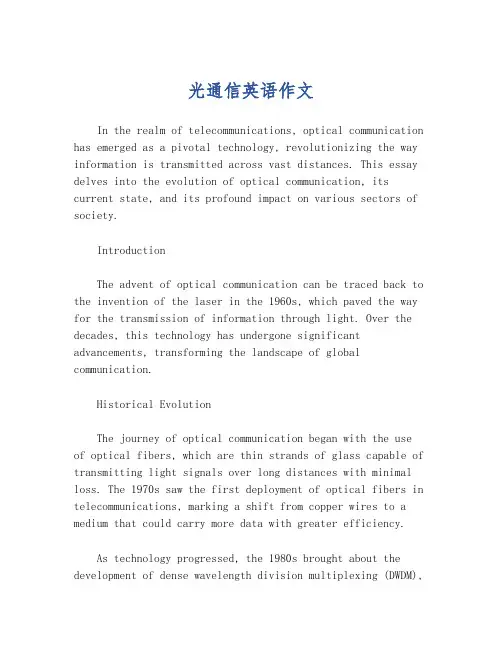
光通信英语作文In the realm of telecommunications, optical communication has emerged as a pivotal technology, revolutionizing the way information is transmitted across vast distances. This essay delves into the evolution of optical communication, its current state, and its profound impact on various sectors of society.IntroductionThe advent of optical communication can be traced back to the invention of the laser in the 1960s, which paved the way for the transmission of information through light. Over the decades, this technology has undergone significant advancements, transforming the landscape of global communication.Historical EvolutionThe journey of optical communication began with the use of optical fibers, which are thin strands of glass capable of transmitting light signals over long distances with minimal loss. The 1970s saw the first deployment of optical fibers in telecommunications, marking a shift from copper wires to a medium that could carry more data with greater efficiency.As technology progressed, the 1980s brought about the development of dense wavelength division multiplexing (DWDM),allowing multiple signals to be transmitted on a single optical fiber by using different wavelengths of light. This innovation significantly increased the capacity of optical communication networks.Current State of Optical CommunicationToday, optical communication is the backbone of the internet and global telecommunications. The technology has evolved to include advanced modulation techniques, such as quadrature amplitude modulation (QAM), which further enhance the data carrying capacity of optical fibers.The integration of optical communication with other technologies, like satellite links and undersea cables, has facilitated the creation of a global network that connects continents. This has led to the rise of cloud computing and the ability to access information and services from anywhere in the world.Technological AdvancementsRecent advancements in optical communication technology include the development of photonic integrated circuits, which combine multiple optical components onto a single chip, and the exploration of quantum communication, which promises unprecedented levels of security.The ongoing research in the field is also focusing on solving the challenges of signal distortion and attenuation in optical fibers, with new materials and designs beingdeveloped to improve the performance of optical communication systems.Impact on SocietyThe impact of optical communication on society is vast and multifaceted. It has facilitated the growth of thedigital economy, enabled high-speed internet access in remote areas, and supported the rise of online education, telemedicine, and e-commerce.Moreover, the high bandwidth and low latency of optical communication networks are critical for emerging technologies such as the Internet of Things (IoT), autonomous vehicles, and smart cities, which require real-time data transmission.Challenges and Future ProspectsDespite its many advantages, optical communication faces challenges such as the high cost of deployment, particularly in developing regions, and the need for skilled technicians to maintain and upgrade the infrastructure.Looking ahead, the future of optical communication is likely to involve further miniaturization of components, increased integration with other technologies, and the development of more efficient and cost-effective systems. The potential for quantum communication to revolutionize data security also holds great promise for the future.ConclusionIn conclusion, optical communication has come a long way since its inception and has become an indispensable part of modern society. Its ability to transmit vast amounts of data quickly and reliably has underpinned the digital revolution and continues to shape the way we live and work. As technology advances, optical communication is set to play an even more significant role in connecting the world and enabling new possibilities.References1. Agrawal, G. P. (2012). Fiber-Optic Communication Systems. Wiley.2. Saleh, B. E. A., & Teich, M. C. (2019). Fundamentals of Photonics. Wiley.3. Zhang, J., & Miao, G. (2020). Recent Progress in High-Capacity Optical Communication Systems. IEEE Communications Magazine, 58(2), 25-31.4. Smith, P. W. (2018). The Role of Optical Fibers in the Evolution of Telecommunications. IEEE Access, 6, 25762-25769.(Note: This essay is a fictional piece created for the purpose of this task and does not contain actual references.)。
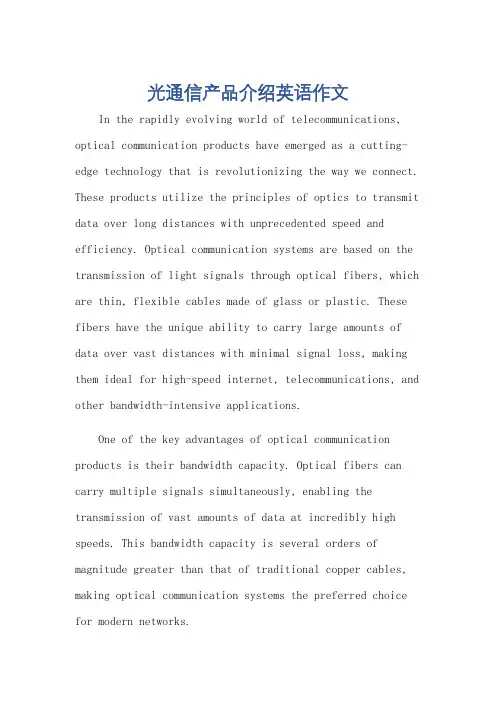
光通信产品介绍英语作文In the rapidly evolving world of telecommunications, optical communication products have emerged as a cutting-edge technology that is revolutionizing the way we connect. These products utilize the principles of optics to transmit data over long distances with unprecedented speed and efficiency. Optical communication systems are based on the transmission of light signals through optical fibers, which are thin, flexible cables made of glass or plastic. These fibers have the unique ability to carry large amounts of data over vast distances with minimal signal loss, making them ideal for high-speed internet, telecommunications, and other bandwidth-intensive applications.One of the key advantages of optical communication products is their bandwidth capacity. Optical fibers can carry multiple signals simultaneously, enabling the transmission of vast amounts of data at incredibly high speeds. This bandwidth capacity is several orders of magnitude greater than that of traditional copper cables, making optical communication systems the preferred choice for modern networks.Another significant benefit of optical communication products is their resistance to electromagnetic interference. Unlike copper cables, optical fibers are not affected by electromagnetic noise, which means that data transmission is more reliable and secure. This is particularly important in environments where there is a lot of electromagnetic activity, such as in industrial settings or around power lines.Optical communication products also offer flexibility and scalability. Optical fibers can be easily installed and modified to meet the changing needs of networks. Additionally, optical communication systems can be easily expanded to accommodate more users and devices without the need for significant infrastructure upgrades.In terms of applications, optical communication products are used in a wide range of industries, including telecommunications, data centers, healthcare, and transportation. In telecommunications, optical fibers are used to transmit voice and data signals between cities and countries, enabling global connectivity. In data centers, optical communication systems provide the backbone forhigh-speed internet and cloud computing services. In healthcare, optical fibers are used for remote patient monitoring, image transmission, and surgical procedures. And in transportation, optical communication products enable real-time traffic monitoring, smart traffic management systems, and connected vehicles.Despite their many advantages, optical communication products also face some challenges. One of the main challenges is the cost of deployment and maintenance. Optical fibers are more expensive than copper cables, and the installation process requires specialized equipment and skilled labor. Additionally, optical communication systems require regular maintenance to ensure optimal performance. Despite these challenges, the future of optical communication products looks bright. With the increasing demand for high-speed, bandwidth-intensive applications, optical communication systems are becoming increasingly important. As technology continues to advance, we can expect even more efficient and cost-effective optical communication products in the future, further革命izing the way we connect and communicate.**光通信产品:革新我们的连接方式**在电信领域快速演变的世界中,光通信产品作为一种尖端技术,正在革新我们的连接方式。
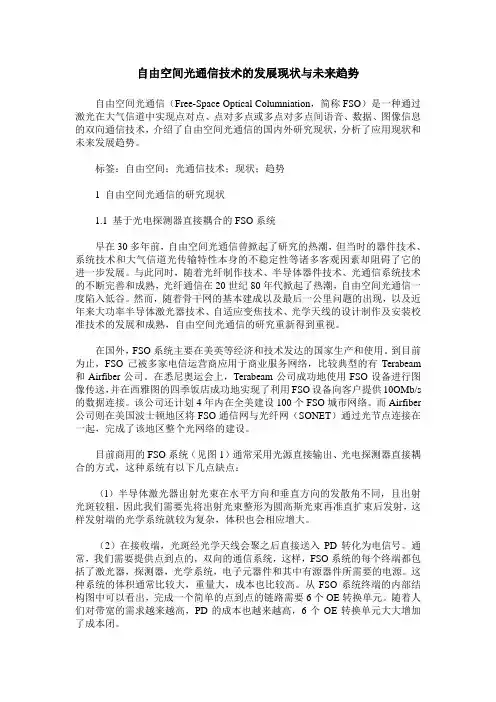
自由空间光通信技术的发展现状与未来趋势自由空间光通信(Free-Space Optical Columniation,简称FSO)是一种通过激光在大气信道中实现点对点、点对多点或多点对多点间语音、数据、图像信息的双向通信技术,介绍了自由空间光通信的国内外研究现状,分析了应用现状和未来发展趋势。
标签:自由空间;光通信技术;现状;趋势1 自由空间光通信的研究现状1.1 基于光电探测器直接耦合的FSO系统早在30多年前,自由空间光通信曾掀起了研究的热潮,但当时的器件技术、系统技术和大气信道光传输特性本身的不稳定性等诸多客观因素却阻碍了它的进一步发展。
与此同时,随着光纤制作技术、半导体器件技术、光通信系统技术的不断完善和成熟,光纤通信在20世纪80年代掀起了热潮,自由空间光通信一度陷入低谷。
然而,随着骨干网的基本建成以及最后一公里问题的出现,以及近年来大功率半导体激光器技术、自适应变焦技术、光学天线的设计制作及安装校准技术的发展和成熟,自由空间光通信的研究重新得到重视。
在国外,FSO系统主要在美英等经济和技术发达的国家生产和使用。
到目前为止,FSO己被多家电信运营商应用于商业服务网络,比较典型的有Terabeam 和Airfiber公司。
在悉尼奥运会上,Terabeam公司成功地使用FSO设备进行图像传送,并在西雅图的四季饭店成功地实现了利用FSO设备向客户提供10OMb/s 的数据连接。
该公司还计划4年内在全美建设100个FSO城市网络。
而Airfiber 公司则在美国波士顿地区将FSO通信网与光纤网(SONET)通过光节点连接在一起,完成了该地区整个光网络的建设。
目前商用的FSO系统(见图1)通常采用光源直接输出、光电探测器直接耦合的方式,这种系统有以下几点缺点:(l)半导体激光器出射光束在水平方向和垂直方向的发散角不同,且出射光斑较粗,因此我们需要先将出射光束整形为圆高斯光束再准直扩束后发射,这样发射端的光学系统就较为复杂,体积也会相应增大。

自由空间光通信标准
自由空间光通信(FSO)是一种采用激光器生成的光束,通过空气从一台设备到另一台设备发送宽带数据、语音和视频的通信方式。
在考虑
到当地气象的条件以后,光无线系统一般可得到99.9%的可用性。
FSO通信系统需要精密、可靠、高增益的收、发天线,来完成系统的双向互逆跟踪。
通常,光通信系统均采用收、发合一天线,隔离度近100%的精密光机组件。
由于半导体激光器光束质量一般较差,要求天线增
益要高,另外,为适应空间系统,天线(包括主副镜、合束、分束滤
光片等光学元件)总体结构要紧凑、轻巧、稳定可靠。
国际上现有系
统的天线口径一般为几厘米至25厘米。
此外,快速、精确的捕获、跟踪和瞄准(ATP)技术也是保证实现空间远距离光通信的必要核心技术。
精跟踪要求视场角为几百μrad,跟踪精度为几μrad,跟踪灵敏度大约为几nW。
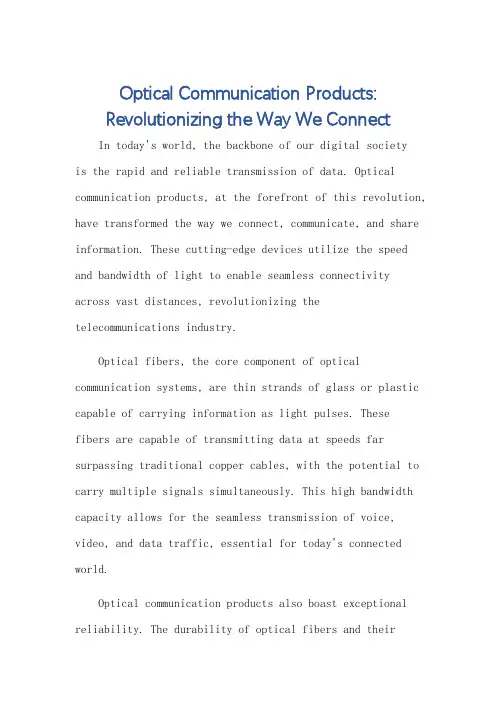
Optical Communication Products:Revolutionizing the Way We ConnectIn today's world, the backbone of our digital societyis the rapid and reliable transmission of data. Optical communication products, at the forefront of this revolution, have transformed the way we connect, communicate, and share information. These cutting-edge devices utilize the speed and bandwidth of light to enable seamless connectivity across vast distances, revolutionizing the telecommunications industry.Optical fibers, the core component of optical communication systems, are thin strands of glass or plastic capable of carrying information as light pulses. Thesefibers are capable of transmitting data at speeds far surpassing traditional copper cables, with the potential to carry multiple signals simultaneously. This high bandwidth capacity allows for the seamless transmission of voice, video, and data traffic, essential for today's connected world.Optical communication products also boast exceptional reliability. The durability of optical fibers and theirresistance to electromagnetic interference makes them ideal for use in a wide range of environments, from dense urban areas to remote locations. This reliability ensures that critical infrastructure such as healthcare, finance, and government services can rely on consistent and secure connectivity.Moreover, optical communication products are highly scalable. As demand for bandwidth continues to grow,optical systems can be easily upgraded to meet these demands. This scalability ensures that optical communication solutions can adapt to the evolving needs of modern society, supporting the continued growth and development of our digital world.In addition to their speed, reliability, and scalability, optical communication products also offer environmental benefits. Their efficient use of energy and reduced carbon emissions compared to traditional copper cables makes them a sustainable choice for the telecommunications industry. As we face the challenges of climate change, the adoption of optical communicationproducts is crucial for reducing the environmental impactof our digital infrastructure.In conclusion, optical communication products are essential for powering our connected world. Their speed, reliability, scalability, and environmental sustainability have revolutionized the telecommunications industry, enabling seamless connectivity and communication across the globe. As we look towards the future, optical communication products will continue to play a pivotal role in shapingthe way we connect, communicate, and share information.**光通信产品:重塑我们的连接方式**在当今社会,我们数字社会的支柱是快速而可靠的数据传输。
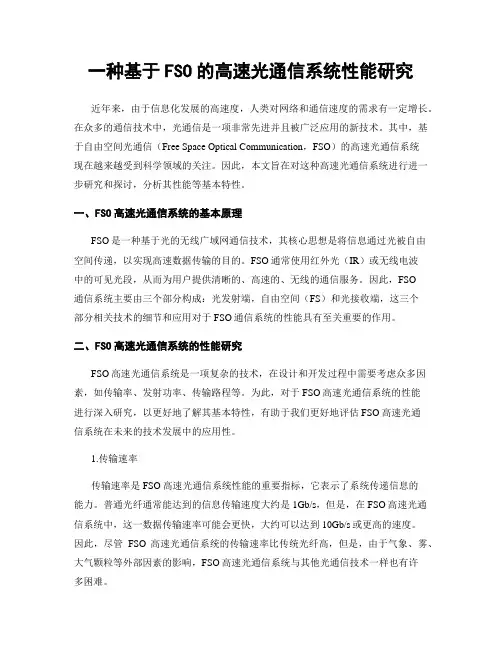
一种基于FSO的高速光通信系统性能研究近年来,由于信息化发展的高速度,人类对网络和通信速度的需求有一定增长。
在众多的通信技术中,光通信是一项非常先进并且被广泛应用的新技术。
其中,基于自由空间光通信(Free Space Optical Communication,FSO)的高速光通信系统现在越来越受到科学领域的关注。
因此,本文旨在对这种高速光通信系统进行进一步研究和探讨,分析其性能等基本特性。
一、FSO高速光通信系统的基本原理FSO是一种基于光的无线广域网通信技术,其核心思想是将信息通过光被自由空间传递,以实现高速数据传输的目的。
FSO通常使用红外光(IR)或无线电波中的可见光段,从而为用户提供清晰的、高速的、无线的通信服务。
因此,FSO通信系统主要由三个部分构成:光发射端,自由空间(FS)和光接收端,这三个部分相关技术的细节和应用对于FSO通信系统的性能具有至关重要的作用。
二、FSO高速光通信系统的性能研究FSO高速光通信系统是一项复杂的技术,在设计和开发过程中需要考虑众多因素,如传输率、发射功率、传输路程等。
为此,对于FSO高速光通信系统的性能进行深入研究,以更好地了解其基本特性,有助于我们更好地评估FSO高速光通信系统在未来的技术发展中的应用性。
1.传输速率传输速率是FSO高速光通信系统性能的重要指标,它表示了系统传递信息的能力。
普通光纤通常能达到的信息传输速度大约是1Gb/s,但是,在FSO高速光通信系统中,这一数据传输速率可能会更快,大约可以达到10Gb/s或更高的速度。
因此,尽管FSO高速光通信系统的传输速率比传统光纤高,但是,由于气象、雾、大气颗粒等外部因素的影响,FSO高速光通信系统与其他光通信技术一样也有许多困难。
2.发射功率在FSO高速光通信系统中,发射功率与传输路程和传输信号之间的关系密不可分,是另一个重要因素。
发射功率代表了使用的光源的强度和发射功率。
为了更好地传输信号,FSO通常使用激光发射器,因为它们在大气环境中很稳定,并且可以更好地达到高信号带宽。
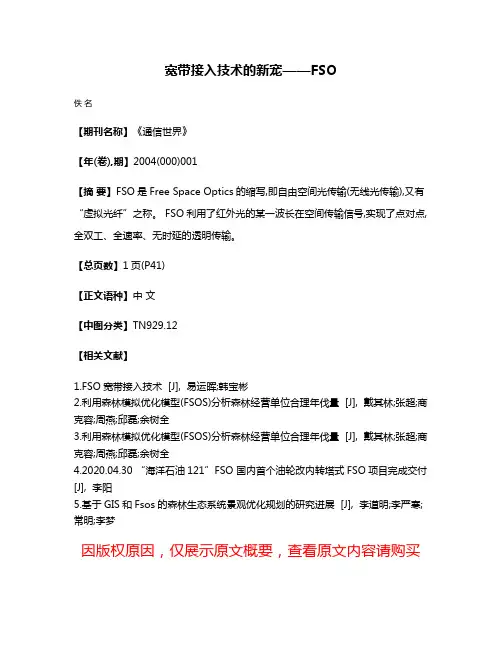
宽带接入技术的新宠——FSO
佚名
【期刊名称】《通信世界》
【年(卷),期】2004(000)001
【摘要】FSO是Free Space Optics的缩写,即自由空间光传输(无线光传输),又有“虚拟光纤”之称。
FSO利用了红外光的某一波长在空间传输信号,实现了点对点,全双工、全速率、无时延的透明传输。
【总页数】1页(P41)
【正文语种】中文
【中图分类】TN929.12
【相关文献】
1.FSO宽带接入技术 [J], 易运晖;韩宝彬
2.利用森林模拟优化模型(FSOS)分析森林经营单位合理年伐量 [J], 戴其林;张超;商克容;周燕;邱磊;余树全
3.利用森林模拟优化模型(FSOS)分析森林经营单位合理年伐量 [J], 戴其林;张超;商克容;周燕;邱磊;余树全
4.2020.04.30 “海洋石油121”FSO 国内首个油轮改内转塔式FSO项目完成交付[J], 李阳
5.基于GIS和Fsos的森林生态系统景观优化规划的研究进展 [J], 李道明;李严寒;常明;李梦
因版权原因,仅展示原文概要,查看原文内容请购买。
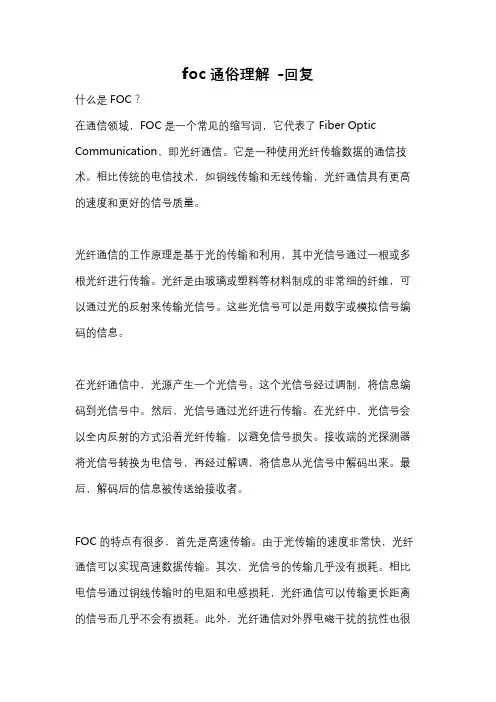
foc通俗理解-回复什么是FOC?在通信领域,FOC是一个常见的缩写词,它代表了Fiber Optic Communication,即光纤通信。
它是一种使用光纤传输数据的通信技术。
相比传统的电信技术,如铜线传输和无线传输,光纤通信具有更高的速度和更好的信号质量。
光纤通信的工作原理是基于光的传输和利用,其中光信号通过一根或多根光纤进行传输。
光纤是由玻璃或塑料等材料制成的非常细的纤维,可以通过光的反射来传输光信号。
这些光信号可以是用数字或模拟信号编码的信息。
在光纤通信中,光源产生一个光信号。
这个光信号经过调制,将信息编码到光信号中。
然后,光信号通过光纤进行传输。
在光纤中,光信号会以全内反射的方式沿着光纤传输,以避免信号损失。
接收端的光探测器将光信号转换为电信号,再经过解调,将信息从光信号中解码出来。
最后,解码后的信息被传送给接收者。
FOC的特点有很多,首先是高速传输。
由于光传输的速度非常快,光纤通信可以实现高速数据传输。
其次,光信号的传输几乎没有损耗。
相比电信号通过铜线传输时的电阻和电感损耗,光纤通信可以传输更长距离的信号而几乎不会有损耗。
此外,光纤通信对外界电磁干扰的抗性也很强。
光信号在光纤中传输时,几乎不会受到外界干扰的影响,从而保证了信号的质量。
光纤通信在各个领域都有广泛的应用。
在长距离通信中,光纤通信成为了主要的通信方式。
由于光纤可以传输信号的距离相对较长,光纤通信在跨越海洋或连接国际之间的通信中起到了重要的作用。
此外,光纤通信也应用于网络通信中的传输和互联网接入。
我们使用的互联网服务提供商将光纤铺设到我们家里,以用于高速网络接入。
光纤通信还应用于医疗领域、工业自动化以及军事通信等领域。
尽管光纤通信具有许多优点,但它也存在着一些挑战和限制。
首先,光纤通信的建设和维护成本较高。
铺设光纤需要大量的投资,并且光纤的维护需要专业技术人员进行。
其次,光纤通信还存在一些技术挑战,例如光纤中的光信号衰减、色散等问题。
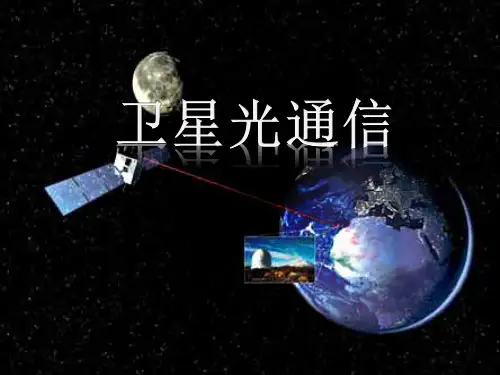
光纤通信英文作文Fiber optic communication is a revolutionary technology that has transformed the way we transmit data. It useslight signals to carry information through thin, flexible glass fibers. This allows for faster and more reliable communication compared to traditional copper wire systems.The use of fiber optic communication has become widespread in various industries, including telecommunications, internet services, and cable television. Its high bandwidth and low attenuation make it ideal for transmitting large amounts of data over long distances.One of the key advantages of fiber optic communicationis its immunity to electromagnetic interference. This means that the quality of the transmitted data is not affected by nearby power lines or other electrical devices, making it a reliable choice for communication in urban areas.In addition to its technical advantages, fiber opticcommunication also offers environmental benefits. The use of fiber optics reduces the need for large amounts of copper wiring, which in turn reduces the demand for raw materials and the energy required for manufacturing and installation.As technology continues to advance, the potential applications of fiber optic communication are expanding. From high-speed internet to advanced medical imaging, fiber optics is playing a crucial role in shaping the future of communication and connectivity.In conclusion, fiber optic communication has revolutionized the way we transmit data, offering faster speeds, greater reliability, and environmental benefits. As technology continues to advance, the potential applications of fiber optics are limitless, making it an essential technology for the modern world.。
FSO通信系统FSO(Free-Space-Optical)自由空间激光通信也被称作激光大气通信或激光无线传输系统。
自从人类发明激光通信以来,从未间断过对自由空间激光通信的研究和开发,但由于各种技术因素和高昂的成本费用,其主要应用于军事通信和太空工业领域。
近年来,由于技术进步和器件材料成本的不断降低,加之市场上对通信带宽旺盛需求和FSO技术能够提供类似光纤的传输速度和带宽,而且无需支付频谱资源占用等其他额外费用,FSO通信系统已开始大量的应用于民用通信系统中。
FSO通信技术有其自身的特殊性,目前主要应用于短距离的高速、高带宽接入系统及应急通信,如语音、Ethernet、视频等。
本文主要阐明FSO技术特点、物理特性及系统设计要点。
一、FSO系统构成FSO通信系统主要由电源子系统、光发射子系统、光接收子系统、监控子系统、恒温除霜子系统及自动跟踪子系统组成。
见图(1)数据接入侧无线侧图(1)FSO系统设备框图电源子系统:电源子系统是给整个FSO系统能量供给的核心部件,分为AC供电和DC供电两种方式。
由于整个FSO设备是在室外工作的,所以,要求电源的稳定性极高,并可适应温差的变化。
光发射子系统:光发射子系统一般是由发射激光二极管和光学透镜组成,激光二极管可采用VCSEL、DFB、FP等,不同的激光二极管决定着发射系统的传输速率。
发射子系统的光学透镜组,决定着光发散角的大小,也就决定了在接收端的光斑面积的大小。
光斑面积越小,则光能量就越大。
因此光发散角是FSO通信系统的重要参数。
大多数FSO的发散角在2个毫弧度左右。
光接收子系统:光接收子系统一般是由激光探测二极管和光学透镜组成。
激光探测二极管可选用PIN-TAI或APD。
APD激光探测二极管具有更低的接收灵敏度,在光功率恒定的状态下采用APD探测管比采用PIN-TAI探测管获得的链路余量要大的多。
另外,激光探测二极管的面积越大,能够耦合的光能量也就越大。
自由空间光通信技术的发展现状与未来趋势1.前言自由空间光通信技术(Free Space Optical Communication,FSO)是一项基于光波传输的通信技术,其通信原理类似于无线电通信,但相对于无线电技术,FSO具有更高的传输速率、更高的带宽、更安全的通信等优点。
随着数字经济和5G应用的发展,FSO技术正在成为人们关注的焦点,本文将就FSO技术的发展现状与未来趋势作一探讨。
2.现状分析FSO技术的优点显著,但其实现存在一些难点,例如信号传输距离短、天气条件的限制等。
当前,FSO技术已经可以实现短距离、小场景的通信,如城市中建筑物之间的通信、机场等开阔区域内的通信等。
但在广阔的宏观场景、不同大洲之间的长距离的通信等方面,FSO技术还有待于进一步发展。
此外,FSO技术实现的应用场景还不够丰富,需要进一步挖掘和探索。
3.发展趋势针对FSO技术发展中的难点和现状,相关领域的研究者正在不断探索和发展。
下面从以下几个方面展开讨论:3.1技术及应用的发展FSO技术的发展需要在技术上取得突破,以满足众多应用场景的需求。
在此基础上,需要进一步挖掘FSO技术的应用场景,例如军事应用、互联网接入等,同时也需要与其他通信技术进行融合发展。
3.2研究与实验的发展FSO技术的研究与实验也是FSO技术发展中重要的一环,其主要任务是探索FSO技术中存在的技术难点,提高技术的可靠性、稳定性和可用性。
同时,在FSO技术的研究和实验的过程中需要进一步减小其成本,以提高商业化应用的可行性。
3.3产业化进程的加速产业的发展是FSO技术的重要节点。
现阶段,FSO技术在智能制造产业、智能交通和数字经济等领域的市场需求已逐渐呈现出爆发式增长。
要加速FSO技术的产业化进程,需要进一步推动技术研究、系统开发、生产制造等各方面的投入,以打造先进的FSO技术产业链。
4.总结FSO技术有着广阔的应用前景,是未来数字经济和5G应用中的一种重要通信技术。
无线光通信1. 简介无线光通信(Wireless Optical Communication)是一种通过无线传播光信号来进行通信的技术。
它利用可见光或红外光进行信息传输,可以实现高速、大容量、安全可靠的无线通信。
无线光通信技术已经得到广泛应用于室内无线网络、无线传感器网络、激光通信、机器人通信等领域。
2. 原理无线光通信的原理是基于光的传输与接收。
发送端使用LED或激光二极管将电信号转换成光信号,经过传输介质(通常是空气)传输到接收端。
接收端的光接收器接收光信号,并将其转换成电信号,从而完成信息传输。
3. 技术细节3.1 发送端发送端通常由以下组件组成:•光源:LED和激光二极管是两种常用的光源。
LED通常用于短距离通信,激光二极管则适用于长距离高速通信。
•调制器:用于将电信号转换成光信号。
常见的调制方式包括振幅调制(AM)、频率调制(FM)和脉冲位置调制(PPM)等。
•光透镜:用于聚焦光信号,提高信号的传输距离和接收效果。
•驱动电路:用于控制光源的亮度和频率。
3.2 传输介质传输介质是无线光通信中的关键因素之一。
在室内环境中,空气是最常见的传输介质。
在一些特殊的情况下,也可以使用其他介质如水、玻璃等作为传输介质。
传输介质的特性会影响光信号的传输距离和衰减情况。
3.3 接收端接收端通常由以下组件组成:•光接收器:用于接收光信号并将其转换成电信号。
常见的光接收器包括光电二极管和光电二极管阵列。
•放大器:用于放大接收到的信号,提高信号的强度和质量。
•解调器:用于将电信号解调成原始的信息信号。
•控制电路:用于控制接收端的工作状态和参数。
4. 优势和应用4.1 优势无线光通信相比传统的无线电通信具有以下优势:•高速传输:无线光通信可以实现几十兆甚至几百兆的传输速率,远高于无线电通信的速率。
•大容量:利用光的频谱资源,无线光通信可以实现更大的数据传输容量。
•低干扰:无线光通信使用的光波不会产生电磁干扰,适用于医疗、航空等对电磁干扰敏感的场景。
1.1 简易无线光通信系统光通信分为有线光通信和无线光通信两种。
光通信的主要方式是有线光通信即光纤通信,它已成为广域网、城域网的主要传输方式之一。
无线光通信又被称为自由空间光通信(FSO,Free Space Optical communication)。
近年来,随着“最后一公里”对高带宽、低成本接入技术的迫切需求,FSO在视距传输、宽带接入中有了新的发展机遇,同时由于光通信器件制造技术的飞速发展,无线光通信设备的制造成本大幅下降,FSO得到越来越多的应用。
本小节介绍用红外光进行语音信号无线传输的简单系统,这种简单的、实验性的无线光通信系统是真实无线光通信系统的简化,其组成如图1-1所示。
图1-1 简易的光无线语音传输系统在一个系统项目开始设计时,要确定实现系统功能的方法原理,并根据项目要求确定系统的需求并发展出一个针对这些需求的计划,即确定系统包括的组成部分、各部分的性能指标以及它们与系统性能之间的关系。
然后根据各个组成部分的指标进行单元电路设计。
通过对简易的光无线语音传输系统设计、制作与调试,目的是:1)了解分析设计的系统需求并发展出解决方案的过程,2)学习单元电路的设计、测试与调整的方法,特别是模拟电路的设计与调试。
1.1.1 系统功能要求及基本解决思路一、系统功能要求1、基本要求(1)设计制作一个可以传送语音信号的无线光通信设备;(2)语音信号频率范围:300Hz~3400Hz;(3)通信距离不小于10m;(4)发送端用驻极体话筒拾取语音;(5)接收端输出到喇叭的最大功率0.5W。
2、扩展要求(1)减小环境光对通信的影响;(2)拓展通信距离(不小于100m);(3)收发两端均采用单电源供电。
第 1 页共20 页2 二、 系统组成及基本解决思路1、系统组成简易的光无线语音传输系统包括发射机系统与接收机系统两个部分组成,如图1-1所示。
系统所用的基本技术是光电转换。
光发射机中的光源受到电信号的调制,通过作为天线的发射光学系统,将光信号通过大气信道传送到接收机的望远镜;接收机望远镜收集接收到光信号并将它聚焦在光电检测器上,光电检测器将光信号转换成电信号。